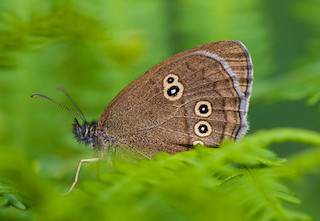 Ringlets may not be as showy as some other butterflies, but they have their own gentle charm.
Ringlets may not be as showy as some other butterflies, but they have their own gentle charm.
Photo: © Allan Drewitt/Natural England
Scientific name: Aphantopus hyperantus
Cornish name: ‘Tikki-dui’ is the general word for butterfly
Conservation status: Least concern
What to look for:
- Colouring: Dark brown when fresh (colour fades with time), with a white fringe to the wings. Small circles on underwings with white centre, black inner and yellow outer ring.
- Size: 48 to 52 mm wingspan (females are larger than males).
- Where: A widespread butterfly, with a preference for damp, shadier places in grassland, clearings, scrub or hedgerows.
- When: On the wing from the end of May until mid-August.
- Similar species: Other brown butterflies, such as the Meadow Brown.
 The Ringlet might be one of those ‘brown’ butterflies, less showy than others such as the Red Admiral and Peacock, but it has its own charm. Look out for its fluttering, bobbing flight amongst its favourite nectar plants of Bramble and Wild Privet. It is more tolerant of cloud and even light rain than many other butterflies, so you can often spot it still flying when the weather turns dull. It achieves this trick due to its dark colouring, enabling it to absorb and retain warmth more efficiently than its paler cousins.
The Ringlet might be one of those ‘brown’ butterflies, less showy than others such as the Red Admiral and Peacock, but it has its own charm. Look out for its fluttering, bobbing flight amongst its favourite nectar plants of Bramble and Wild Privet. It is more tolerant of cloud and even light rain than many other butterflies, so you can often spot it still flying when the weather turns dull. It achieves this trick due to its dark colouring, enabling it to absorb and retain warmth more efficiently than its paler cousins.
The dark velvet-brown of the Ringlet’s upper wings is offset by a white fringe and darker eyespots (the latter are sometimes absent), while its underwings have varying numbers of white spots ringed with an inner ring of dark brown and an outer ring of yellow. The appearance of these rings is also variable, sometimes elongated, and sometimes lacking the black inner ring.
Ringlets are actually in the same family of butterflies (Nymphalidae) as the more dramatic Fritillaries and Emperors, forming a sub-family of their own (Satyrinae). You can find them in tall damp grassland, hedgerows and woodland clearings. One brood is produced each year: the adults emerge from mid-June to July, tailing off in August. The larval foodplants are grasses, including Cock’s-foot, False Brome, Fescues and Meadow-grasses.
Did you know…?
…Females scatter their eggs fairly chaotically into vegetation. However, this is not carelessness: the eggs drop to the bottom of the grass, where they are then very well hidden from any predators.
…The flight time of the Ringlet (about eight weeks) is relatively short.
More information and references:
Wacher, J., Worth, J. and Spalding, A., 2003. A Cornwall Butterfly Atlas. Pisces Publications, Newbury, Berkshire.
Whalley, P. and Lewington, R., 2009. The Pocket Guide to Butterflies. Bounty Books, London.
Published: July 2014
Author: Amanda Scott
Photos: Upper, © Allan Drewitt/Natural England; lower, Amanda Scott

